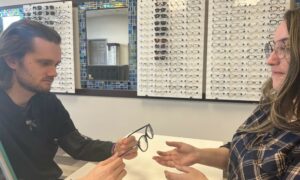By Diane Palombi, OD
January 28, 2015
Ophthalmic lens remakes are costly to your practice, and lower the quality of the patient experience–but following a few simple rules can greatly limit such remakes.
A recent experience in my own family illuminated the challenges associated with limiting remakes, and some of the ways I kept remakes to a minimum when I was in practice.
My husband recently had his first eye exam from an optometrist that wasn’t yours truly. Unfortunately, it did not go well. The second he put on his new prescription he knew it wasn’t right. The optometrist had bumped up his prescription in both eyes considerably, but his right eye had been changed even more than his left. The optician told him that he needed to adapt to the new script and wear them for a while. He gave it a few days, but was back for a recheck as soon as he could be scheduled in.
I inquired about certain procedures that I did if I had reservations about a new prescription change. My husband said that none of them had been performed. He does not have a difficult prescription. Over the decades that I examined him, I have not had to do a remake other than take him out of progressive lenses, which he refused to adapt to.
I always hated doing rechecks. When I worked at Lenscrafters, I was so busy that I did not like that they took time away from doing regular exams. I also felt that I had failed the patient to a certain extent. Sure, with the one-hour service, they typically did not have to make a second trip back, but it still involved spending more time with me than they had planned on. My Lenscrafters location had good opticians and lab managers, so lab or optician errors were caught right away for the most part. When I started my own practice, remakes meant money out of my pocket, so I tried to avoid them at all costs. Also, with the longer delivery time, a remake was an inconvenience for the patient. It involved coming into the office at least two more times.
Here are some tips that have helped me out over the years:
Take acuities through new prescription. If a patient complains of blur, take their acuities through the new prescription. I was shocked that this did not happen with my husband. This would save at least one trip for the patient if the vision through the new glasses is poor. I think they would rather wait a few minutes for the doctor to be available than make another trip. If the acuity is good, then it really may be an adaptation problem. Keep in mind that absolute presbyopes are not going to relax their eyes into more plus. That only happens with younger patients, so your opticians better be aware of that fact.
Use Loose Lenses Or Flipper Bars. Loose lenses or flipper bars are great tools to use for a questionable prescription change that does not involve a change in the astigmatism correction. They can be used after the initial exam over the patient’s present prescription to demonstrate the change. I usually did this out of the exam room in real life conditions. They can also be used if the patient has problems with their new prescription. If the new prescription involved an astigmatism change, I would trial frame the prescription. Again, you want to do this out of the exam room in a more natural setting. That way a patient can move around. Walking, moving their head or eyes might make the prescription seem different than sitting stationary behind a phoropter.
Don’t Necessarily Prescribe What You Refracted. You do not have to prescribe what you refracted. If a patient had a big change, sometimes I would cut back on it somewhat, especially with plus powers. This is also true with adds. If you really bump up an add, it could mess up things like their computer screen that they now cannot see as well, but are not ready for a trifocal or progressive lens. I often did ranges through the phoropter so I could show the patient how the new add power would affect their working distances. Sometimes the patient would rather compromise by going with a slightly weaker prescription to avoid bifocals or trifocals one more time. Occasionally we would even use our computer station as a demonstration where, again, we used loose lenses or flipper bars to show how different adds affected their vision at different distances. I also did not like to make a huge change to just one eye. It may look clearer sitting down behind the phoropter, but can mess the patient up in the real world. I would try to find a happy median.
Balance Prescription Between Two Eyes. I felt that balancing the prescription between the two eyes was important. You may have two clear images, but if the brain fights to put them together, you have a big problem. When I used prism to check the images at the same time, I would sometimes use two methods to make certain the final results agree.
Hold Back on Holding Multiple Pairs. If you are not feeling confident about a prescription change, now is not the time to change the lenses in multiple pairs of glasses. Just order one pair first. If everything is fine at the dispense, then you can order up prescription sunglasses, computer glasses and other pairs the patient may need. Remaking multiple pairs of glasses can take a big bite out of your profits, or even negate them.
Ask Patients how Quickly their Vision Became Blurry. Diabetics, especially undiagnosed ones, can cause many a remake. It is a red flag if a visual change was sudden and not gradual. Sudden changes usually suggest some sort of pathology that needs to be discovered first. Also inquire if the vision fluctuates. Diabetics again can fluctuate in their vision, but so can other conditions like corneal issues. Although it is an inconvenience to the patient, I would not prescribe in these instances. If I suspected the patient was diabetic by a huge myopic shift, I would recommend an evaluation by their primary care doctor. Once their sugar was stable, then we would finish the exam.
Do Second Refraction on Dry Eye Patients. Dry eye issues could also warrant a second refraction. If I didn’t feel comfortable with the prescription change, I would rather play it safe and do a second refraction on a different day. If the refractions were the same, then it is safe to prescribe. Fortunately, this did not occur too often, but I had patients come back more than twice before their refractions were stable.
Think Twice Before Changing Cataract Patient Prescriptions. I usually would not change the prescription of a patient with cataracts who had huge myopic shifts. The change would only help for a short period of time. It usually was better for the patient in the long run to have a cataract extraction evaluation instead.
KISS. I was a firm believer in KISS (Keep it simple, stupid!) and “If it isn’t broke, don’t try to fix it” philosophies. The newest lens technology is not going to work for everyone. If a person is happy with a certain type of lens, let it be. Don’t create problems. Patient education is so important. If you are going to try something new, you need to tell the patient both the pros and the cons. That way the patient knows what is normal when they get their new prescription.
You can never avoid doing rechecks and remakes. However, when you are in doubt, just do a few extra steps to prevent you and your patients the aggravation of a recheck and remake. Your patient–and your bank account–will thank you for it.
How does your practice limit remakes? What approaches have worked best for you and your optical team?
Diane Palombi, OD, now-retired,owned Palombi Vision Center in Wentzville, Mo. To contact her: dlpod1@hotmail.com

























